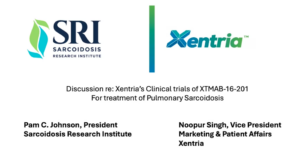Sarcoidosis is a diagnosis of exclusion, meaning that doctors will oftentimes rule out all other possibilities prior to confirming that your symptoms are caused by sarcoidosis. This is primarily due to the way sarcoidosis symptoms mimic other diseases and is a factor in the frequent misdiagnosis of sarcoidosis. There is no single diagnostic tool used to diagnose sarcoidosis, and more often than not, a combination of diagnostic techniques are used to narrow down the root cause of your symptoms.
How is Sarcoidosis Diagnosed?
While sarcoidosis cannot be diagnosed with a specific diagnostic tool, it is typically diagnosed through a combination of physical examinations and biopsies. The primary tools used to diagnose sarcoidosis may include:
Medical history and physical examination: This is the first step for doctors to gather additional information and determine whether your symptoms could be caused by something in your history.
Chest X-rays: A painless test that allows your doctor to look at your lungs and airways thoroughly. Although more than 90% of people with sarcoidosis will have abnormal X-rays, it is not the only condition that will cause them. Signs of sarcoidosis are often seen in X-rays ordered for other reasons, such as general chest pain or rhythmic issues.
Pulmonary function tests: Also called PFTs, a pulmonary function test assesses how well your lungs are working. Your doctor may have you breathe into a mouthpiece that is attached to a spirometer, or a device that measures the amount and speed of air you blow out. Lungs that are affected by sarcoidosis typically do not work as well as healthy lungs.
Bronchoscopy: During a bronchoscopy, a small tube is passed down the windpipe and into the airways of the lungs. This process will inspect the bronchial tubes and take a tissue biopsy to look for granulomas and rule out infection. Although done in a hospital, this procedure does not require admission.
An eye exam: Ocular sarcoidosis can manifest in the eyes, so an eye exam may be needed to check for signs of sarcoidosis. An ophthalmologist will examine your eyes, dilate your pupils, and potentially evaluate the tear-producing glands using the Schirmer test since dry eyes are common with sarcoidosis.
Blood tests: Those with sarcoidosis often make excess amounts of both vitamin D and a chemical called angiotensin-converting enzyme, and blood tests can be used to detect high levels of these substances. However, a blood test cannot be used to diagnose sarcoidosis due to other conditions also causing elevating levels, but it can be used to look for evidence of liver and kidney damage.
A CT scan: This scan can identify enlarged lymph nodes or scarring in the lungs that may not appear in a regular chest x-ray. Some CT scans require the use of contrast, which will either be given by IV or ingested prior to an exam. Your doctor will be able to give you the details of your specific CT scan prior to your appointment.
A Gallium scan: During a gallium scan you will get gallium, a radioactive material injected into your veins. The gallium then travels through the bloodstream and collects in the bones and certain organs. At a later time, typically 6 to 48 hours after injection, a scan will take place to determine if gallium has collected in any abnormal areas, which can be a determiner for sarcoidosis. Although gallium is a radioactive material, the risk for radiation exposure is less than that of an x-ray or CT scan.
Positron emission tomography (PET) scan or magnetic resonance imaging (MRI): A PET scan, a positron emission tomography, or an MRI can be used to look for signs of sarcoidosis in the brain, spinal cord, heart, bones, or other organs. They can also be used for determining a good spot to perform a biopsy.
An electrocardiogram (EKG): An EKG records the electrical activity of the heart and helps identify any strain on the heart itself. Because many sarcoidosis patients experience irregular heart beats, EKGs help identify if those are present.
Biopsies: If a part of the body is believed to be affected by sarcoidosis, a small sample of tissues, called a biopsy, can be taken to the lab to perform tests on, such as looking for granulomas.
The complexity of sarcoidosis makes it difficult to diagnose until symptoms begin to present themselves. The majority of sarcoidosis cases are diagnosed between the ages of 25 and 40. However, children and older adults can also experience sarcoidosis symptoms. In addition, sarcoidosis affects women more frequently than it affects men.
Receiving a Sarcoidosis Diagnosis
If you have already received a sarcoidosis diagnosis or are anticipating one, you may be wondering what to do next. First, choosing a doctor who is familiar with sarcoidosis and its corresponding treatment is important. It may also benefit you to gather further information on sarcoidosis itself through national healthcare organizations. Depending on your location, there may be support groups available for you to meet others with sarcoidosis and discuss your experiences.
Learn More About Sarcoidosis